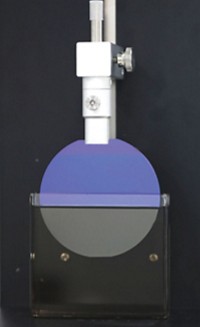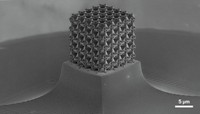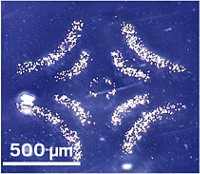Advertisement
Grab your lab coat. Let's get started
Welcome!
Welcome!
Create an account below to get 6 C&EN articles per month, receive newsletters and more - all free.
It seems this is your first time logging in online. Please enter the following information to continue.
As an ACS member you automatically get access to this site. All we need is few more details to create your reading experience.
Not you? Sign in with a different account.
Not you? Sign in with a different account.
ERROR 1
ERROR 1
ERROR 2
ERROR 2
ERROR 2
ERROR 2
ERROR 2
Password and Confirm password must match.
If you have an ACS member number, please enter it here so we can link this account to your membership. (optional)
ERROR 2
ACS values your privacy. By submitting your information, you are gaining access to C&EN and subscribing to our weekly newsletter. We use the information you provide to make your reading experience better, and we will never sell your data to third party members.
Materials
Molecular-Scale Lithography
Advances in block copolymer self-assembly may lead to applications in microelectronics
by Celia Henry Arnaud
October 20, 2008
| A version of this story appeared in
Volume 86, Issue 42

MOORE'S LAW, named for Intel cofounder Gordon E. Moore, predicts that the number of transistors on computer microprocessors will double every two years. Until now, standard photolithography, in which laser beams are used to generate patterns in masks and transfer those patterns to a substrate, has been sufficient to satisfy the need for tinier transistors.
But that might not be the case much longer.
"We can't shrink the features down much further" with standard photolithography, says Craig J. Hawker, a chemistry professor at the University of California, Santa Barbara. "It's becoming too expensive to make sub-30-nm features."
This is where block copolymer lithography comes in, Hawker adds. "It is an attempt to keep up with Moore's law."
Block copolymer lithography harnesses the power of chemistry to reduce feature size even further, potentially smaller than 10 nm. "It's not a replacement for photolithography," Hawker says. "It's an add-on."
Block copolymer lithography takes advantage of spontaneous self-assembly processes to create arrays of molecular-scale features whose size is dictated by the chemistry of block copolymers. Typically, the process relies on diblock copolymers, which are covalently linked chains of two different polymers. The two chains that make up the diblock copolymer would "separate at a very large length scale if they weren't tied together at the molecular length scale," says Paul F. Nealey, a chemical engineering professor at the University of Wisconsin, Madison.
A common outcome of block copolymer lithography is a hexagonally packed array of features. But Edward J. Kramer, Glenn H. Fredrickson, Hawker, and their coworkers at UCSB recently showed that they can get different types of arrays by adjusting the hydrogen-bonding properties of a blend of designer block copolymers (Science, DOI: 10.1126/science.1162950). Their modified block copolymers self-assemble into square arrays of cylinders.
The UCSB team harnesses competing forces to control the orientation and pattern of the arrays. "We're using the fact that the polymers hate each other so they want to get away from each other when blended," Hawker says. "But then, we're using the attractive force of the hydrogen bonding to keep them together and give us different patterns."
Usually, block copolymer lithography involves only one block copolymer. The UCSB group, however, blends two different block copolymers. One copolymer consists of poly(ethylene oxide) (PEO) and polystyrene. The second copolymer contains polystyrene and poly(methyl methacrylate) (PMMA). Each polymer block performs a specific role in the blend. The PMMA blocks are photodegradable, so they can be easily removed to generate pores. The hydrophilic PEO provides long-range ordering. The polystyrene acts as a matrix for the other polymer blocks.
The polystyrene blocks are randomly modified with small amounts of 4-hydroxystyrene in one copolymer and 4-vinylpyridine in the other to promote hydrogen bonding. Adjusting the ratio of hydrogen-bond donors and acceptors causes the block copolymer mixture to assemble differently.
Some ratios still form the typical hexagonal array, but a 1:1 ratio of donors and acceptors assembles into square arrays. "There seems to be a delicate balance between the desire of the block copolymers to separate and the desire for the hydrogen bonds to keep the blend together," Hawker says.

FINDING APPLICATIONS for block copolymer lithography in the microelectronics and computer industries will require more than just broadening the range of patterns that can be made with the technique. For such applications, features must be uniform and individually addressable. "You need to be able to place every domain exactly where you want it on the substrate," Nealey says. Gaining acceptance for block copolymer lithography in microelectronics applications will require reaching levels of perfection with only one defect in 1 million, 10 million, or 100 million features, he asserts.
Achieving that level of perfection probably will require some type of templating process. At the moment, block copolymer self-assembly forms ordered structures only over short distances. Before the method can become a practical lithography tool, it must be capable of producing long-range order. Two teams recently reported ways to impose the needed long-range order on the block copolymer self-assembly process.
Caroline A. Ross, Edwin L. Thomas, Karl K. Berggren, and their coworkers at Massachusetts Institute of Technology use a physical template to impose order on the block copolymers (Science 2008, 321, 939). Their template consists of a two-dimensional array of posts made of hydrogen silsesquioxane on a silica substrate, all coated with a thin layer of poly(dimethylsiloxane) (PDMS) brush.
The researchers have found that a PDMS/polystyrene block copolymer self-assembles in a hexagonal pattern around the posts. Each post occupies a spot otherwise earmarked for a PDMS feature.
"You end up with a structure that has essentially perfect long-range order because it's pinned at various places by these little pillars," Ross says. "You'd like to be able to get whatever pattern of block copolymer you want with the sparsest or simplest template or post array. We want to find out how little work we can do on the template and still get the polymer to fill in the gaps the way we want."
Chemical methods can also be used to render the surface into a template. Nealey's team, in collaboration with scientists at Hitachi Global Storage Technologies, does this by using an electron beam to draw a pattern in a polystyrene brush layer on a silica substrate (Science 2008, 321, 936). They then expose parts of the pattern to an oxygen plasma. During self-assembly, the PMMA portions of a polystyrene-PMMA block copolymer preferentially interact with the oxidized portions.
Polymer self-assembly on top of this kind of chemical template generates many more features than were in the template itself. The same is true with the physical templates used by Ross. With such "density multiplication" of features, there is not a one-to-one correspondence between the features in the underlying template, be it physical or chemical, and those in the block copolymer layer.
Density multiplication overcomes one of the biggest challenges for standard photolithography. "It's always easy to make small features," Nealey says. "What's hard when we go to smaller dimension features is getting ones that are packed close together and all exactly the same size."
Ross's and Nealey's methods use standard lithography methods to generate the underlying template. Their technology is nonetheless promising, Nealey says, because the templates don't have to be of the same quality or uniformity that is required for the final products. "The assembly of the block copolymer corrects for many mistakes you could make in the process of chemical patterning" of the template, he notes.
Hawker plans to combine his chemical modifications with template-patterning techniques such as those reported by Ross and Nealey. "Registration is really critical for a number of applications," Hawker says. "You'd like to know where your square array starts and be able to control the registration as you move away from that starting point."

IT MAY NOT BE long before patterning methods based on block copolymer lithography find their way into industrial applications.
Patterning "is an important new technology for us in hard disk drives," says Thomas R. Albrecht, manager of the patterned media technology group at Hitachi Global Storage Technologies and leader of the team that collaborated with Nealey's group. "We need this much sooner than the semiconductor industry will ever get to it."
Hitachi is interested in using such methods to create the templates for patterning tiny magnetic islands to use in hard disk drives. Dissolving the PMMA microdomains creates holes in the surrounding network of polystyrene, which can be used as a mask for transferring the pattern from the polymer into the surface of a template that, in turn, can be used for nanoimprinting. Nanoimprinting allows the pattern to then be replicated on many disks via a process that resembles printing.
"The big question has been: How can we perform the lithography to create islands in the size range we need," Albrecht says. A typical specification would call for islands that are 15 nm in diameter and separated, center-to-center, by 25 nm. That's beyond the reach of standard lithography methods, he notes.
Albrecht acknowledges that he was initially skeptical about self-assembly techniques. "The scenarios people talked about tended to be way too ambitious," he says. "The dream is that you'd mix some stuff up in a vial, pour it out on a surface, let it go to work, and come back the next day and your pattern is formed."
By creating the template first, the task of self-assembly becomes a matter of filling in the missing dots. "That's a much easier task than creating the perfect pattern from nothing," Albrecht says.
Although Albrecht is hopeful that the technology will succeed, other hurdles, such as fine-tuning the islands' magnetic properties, must be overcome first. "We hope that over the next few years we're able to have the breakthroughs we need in some of the other areas, just as this block copolymer method was a real breakthrough."





Join the conversation
Contact the reporter
Submit a Letter to the Editor for publication
Engage with us on Twitter